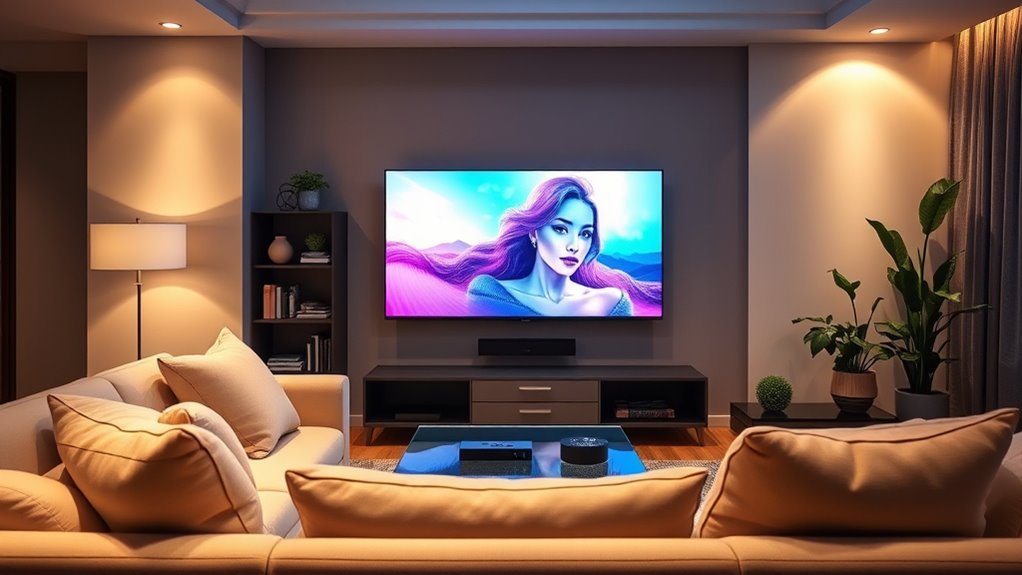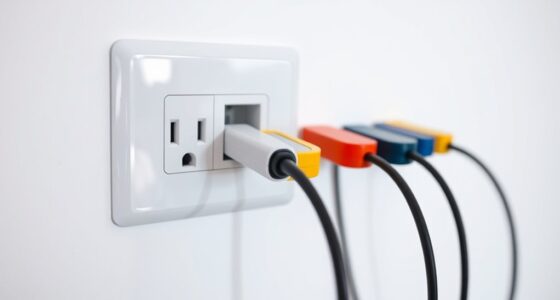When shopping for a smart TV, bigger isn’t always better. Larger screens can lead to hidden costs like wall mounts, sound upgrades, and furniture changes. They also might not fit your space or offer ideal viewing angles. Balance your room size, budget, and desired features to get the best experience. If you want to avoid surprises and make an informed choice, keep exploring the factors that influence smart TV setups.
Key Takeaways
- Larger TVs may incur hidden costs like professional mounting, upgraded sound systems, and additional furniture, increasing overall expenses.
- Assess your room size and lighting to choose a screen that fits well without causing glare or overwhelming the space.
- Bigger screens can reduce picture quality at wide angles and lead to color distortion if not properly positioned.
- Balance features and budget by prioritizing essential functions over high-end extras to avoid unnecessary spending.
- Focus on your specific room setup and usage needs to select a size that enhances viewing experience without overspending.
The Hidden Costs of Going Large
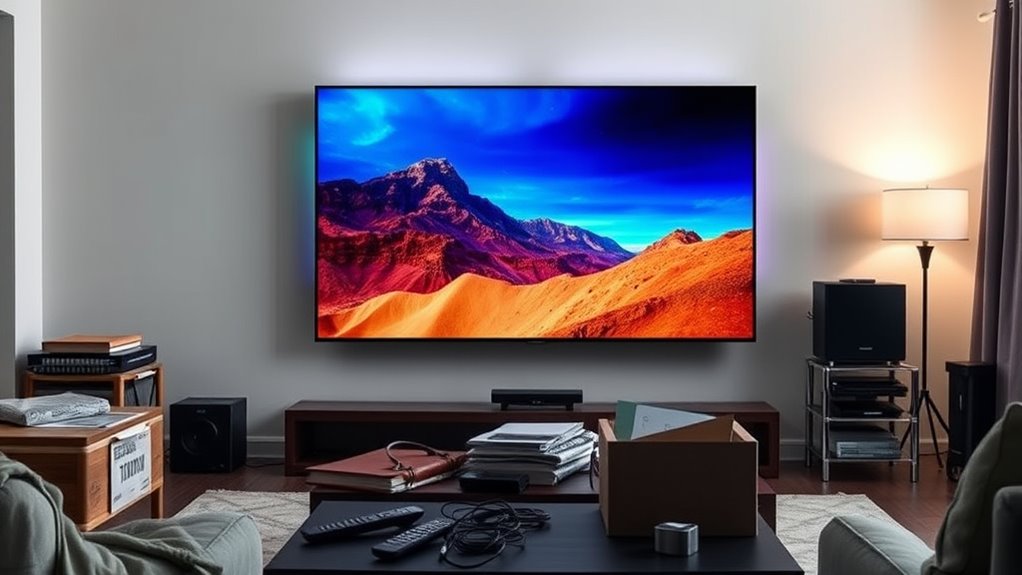
While a larger TV might seem like the best choice for a more immersive viewing experience, it often comes with hidden costs that catch many shoppers off guard. For one, wall mounting a bigger screen can require specialized brackets and professional installation, adding to your expenses. Plus, larger TVs often demand upgraded sound systems since built-in speakers might not deliver quality audio at higher volumes or for richer sound. Without proper sound support, your viewing experience can feel lacking, defeating the purpose of a bigger screen. Additionally, bigger TVs may require you to rearrange furniture or invest in furniture mounts, further increasing costs. It’s also important to consider how the digital age has influenced consumer expectations and the importance of balanced entertainment setups. Remember, bigger isn’t always better if you overlook these hidden expenses that come with size.
Assessing Your Space and Viewing Environment
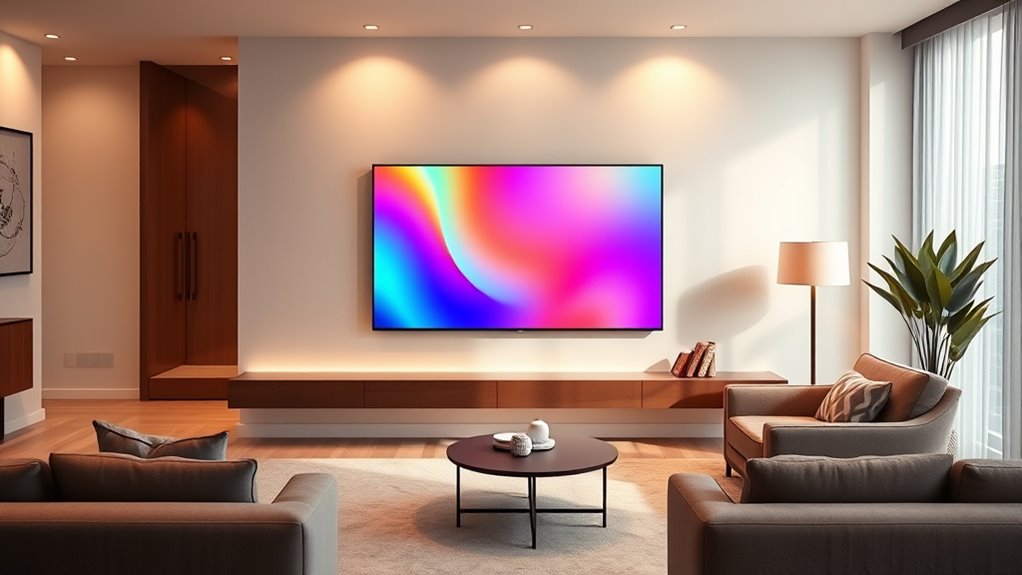
Before choosing the perfect TV size, you need to evaluate your space and viewing environment carefully. Consider how screen placement impacts comfort and visibility; a well-positioned TV reduces neck strain and glare. Ambient lighting also plays a vital role—bright rooms may require anti-reflective screens, while dim areas benefit from softer lighting. Use the table below to assess your setup:
| Aspect | Recommendations | Considerations |
|---|---|---|
| Screen Placement | Eye level, centered, away from windows | Avoid glare and reflections |
| Ambient Lighting | Soft, indirect light; control natural light | Minimize glare and reflections |
| Room Size | Match TV size to room dimensions | Prevent overwhelming space |
Additionally, understanding contrast ratio helps ensure your viewing environment complements your TV’s image quality, especially in darker rooms. Evaluating these factors ensures your TV fits seamlessly into your environment, enhancing your viewing experience.
Impact on Picture Quality and Viewing Angles
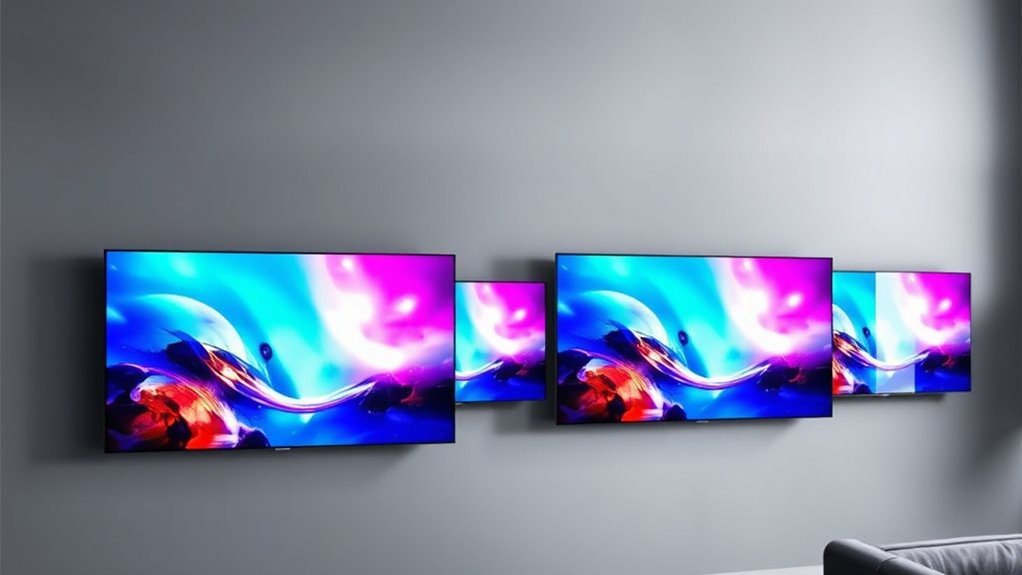
The impact of picture quality and viewing angles is essential when selecting a smart TV, as these factors directly influence your overall viewing experience. Larger screens often lead to resolution trade-offs, where image sharpness may diminish at wider angles. When you sit off-center, color accuracy can fade, causing colors to look dull or distorted. To guarantee ideal picture quality, look for TVs with wide viewing angles that minimize these issues. Keep in mind that some models compromise resolution or color reproduction to achieve better angles. Monitoring air quality indicators can help you determine the optimal placement and usage conditions for your TV to maintain consistent picture quality.
Balancing Features and Budget

Choosing a smart TV involves finding the right balance between features you want and the budget you have. Look for remote control ergonomics that make navigation comfortable and intuitive, saving you frustration during long viewing sessions. Don’t just chase the latest tech; consider the smart TV app diversity, ensuring the platform offers streaming services and apps you regularly use. It’s tempting to opt for higher-end models packed with features, but that can quickly inflate costs. Instead, identify the essential features that improve your viewing experience without overspending. A well-balanced TV provides good picture quality, a user-friendly interface, and useful smart features, all within your budget. Additionally, evaluating the design and layout of your entertainment setup can enhance your overall viewing experience and ensure the TV fits well in your space. This approach lets you enjoy a satisfying upgrade without sacrificing financial peace of mind.
Making an Informed Choice for Your Home Setup
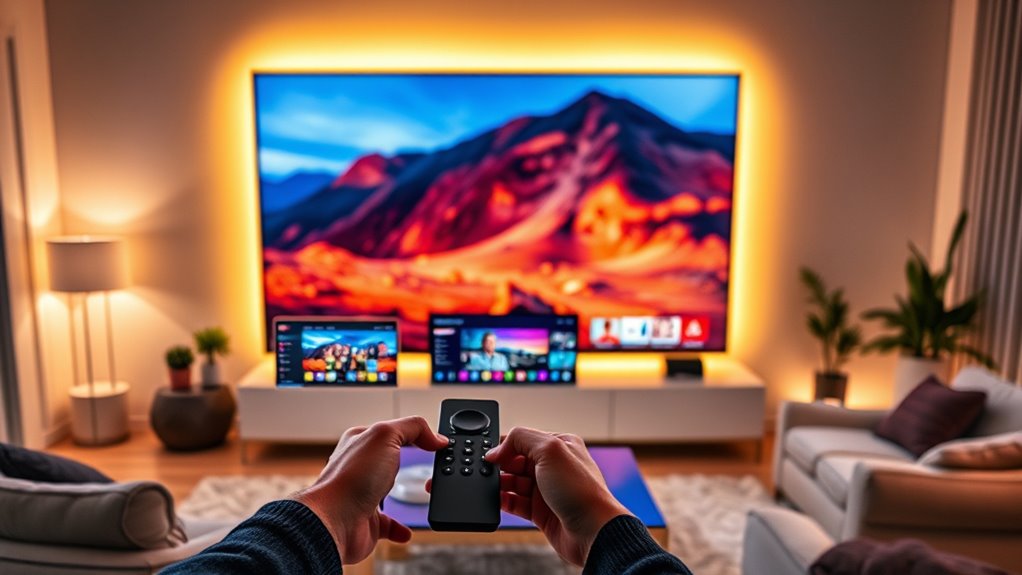
To make an informed choice for your home setup, start by evaluating your space and how you’ll use your smart TV. Consider factors like room size, lighting, and seating arrangements. Think about your preferred features, such as voice control and smart integrations, which can simplify navigation and connect your TV seamlessly with other devices. Visualize your ideal setup with these points in mind:
- Room size and viewing distance
- Ambient lighting conditions
- Sound system compatibility
- Ease of access to voice control
- Compatibility with other smart home devices
Choosing a TV with the right size, smart features, and integration options ensures a smooth experience. Focusing on your specific needs helps you avoid overspending on unnecessary features or size. Additionally, being aware of support hours can be useful if you encounter technical issues or need assistance with your smart TV setup.
Frequently Asked Questions
How Do I Determine the Optimal TV Size for My Room?
To find the ideal TV size for your room, consider your room layout and viewing distance. Measure how far you’ll sit from the screen, ideally about 1.5 to 2.5 times the TV’s diagonal size. A smaller room benefits from a smaller TV, while a larger space can handle a bigger screen. Keep in mind that a comfortable viewing experience depends on balancing size with your room’s dimensions.
What Are the Energy Consumption Differences Between Large and Smaller TVS?
When comparing energy consumption between large and smaller TVs, you’ll notice that larger screens generally use more power due to bigger displays and higher brightness levels. However, newer models focus on energy efficiency, so a smaller TV might actually consume less power overall. To save energy, look for TVs with a high energy efficiency rating and features like LED technology, which help reduce power consumption without sacrificing picture quality.
Do Bigger TVS Require Special Mounting or Installation Considerations?
Imagine your giant TV crashing down like a falling skyscraper! Bigger TVs often need special mounting brackets to stay secure, and you’ll need ample wall clearance to prevent accidents. Make certain your wall can handle the weight and size, and choose sturdy mounts designed for larger screens. Proper installation avoids disasters and guarantees your giant screen stays safely in place, providing an immersive experience without the risk of a catastrophic fall.
How Does Screen Size Affect Remote Control Usability?
When it comes to screen size, larger TVs can make remote control usability a bit tricky. You might find it harder to reach all buttons comfortably or see the screen clearly from different angles. Voice commands can help, but good remote ergonomics are essential. A bigger screen doesn’t mean you can’t control your TV easily—just choose a remote that fits your hand and supports voice control for a better experience.
Are There Health Concerns Associated With Very Large Screens?
Imagine your eyes straining to take in a massive screen, forcing you to keep your neck craned or eyes darting uncomfortably. Very large screens can cause eye strain and posture issues, leading to headaches or neck pain over time. You might find yourself constantly adjusting, risking long-term discomfort. So, while bigger screens seem impressive, they can pose health concerns that make moderation and proper positioning essential for your well-being.
Conclusion
Choosing a bigger TV isn’t just about size; it’s about finding the perfect fit for your space and lifestyle. Think of your TV as the star of your living room stage—bigger isn’t always brighter. By weighing the hidden costs, viewing comfort, and your budget, you’ll craft a home theater that feels just right. Remember, the best screen is the one that makes your favorite shows shine without overwhelming your space.
